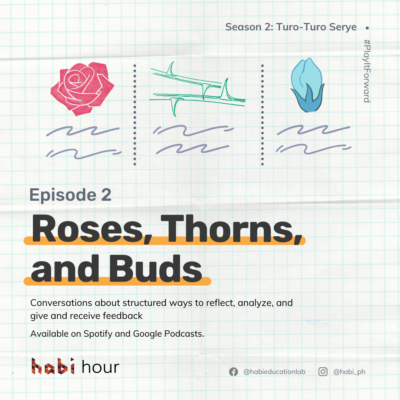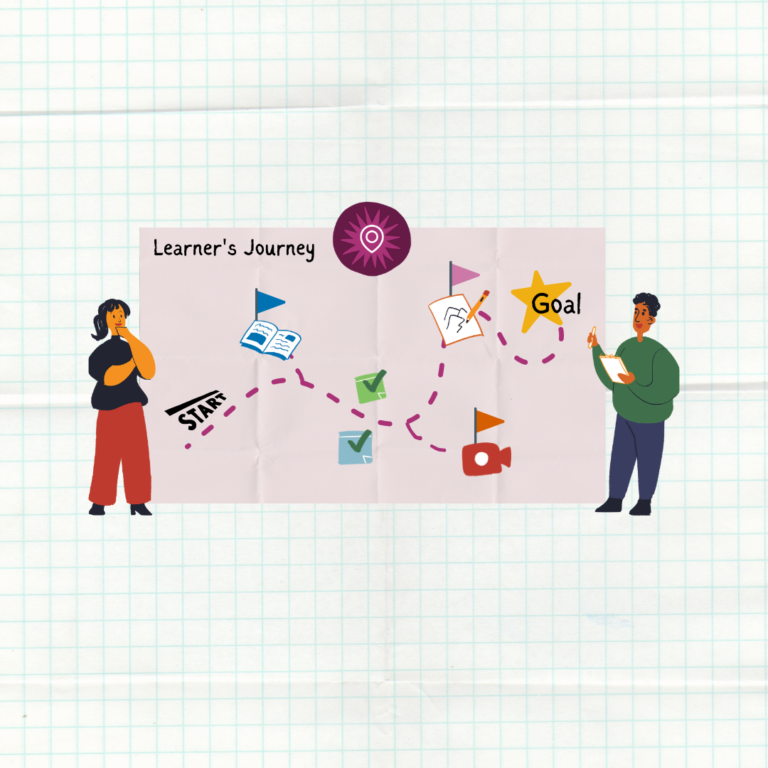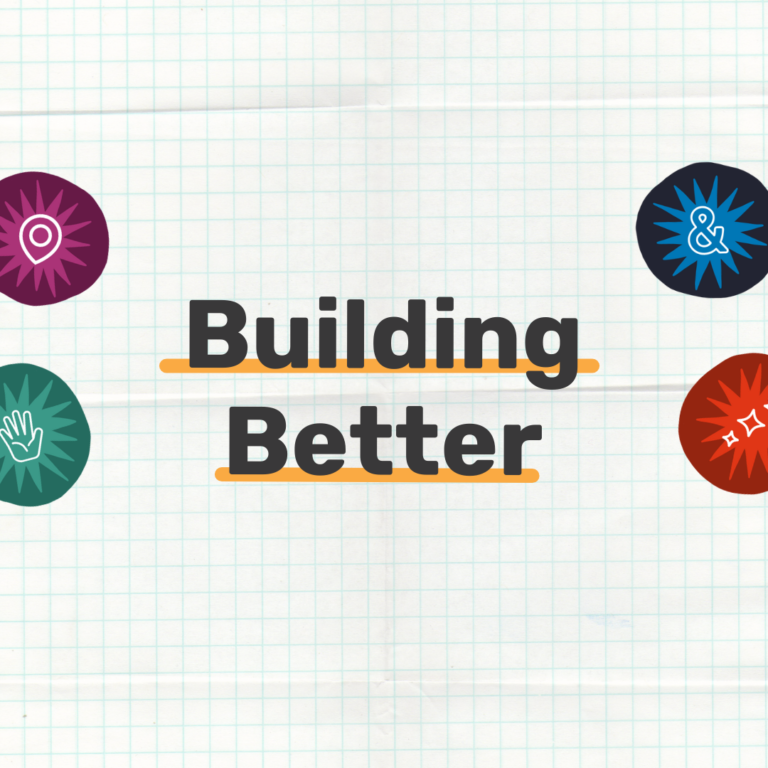Conversations about structured ways to reflect, analyze, and give and receive feedback
Overview
18 April 2021 | 16 min and 09s
Have you ever wondered, “What’s a creative way for giving constructive feedback?” or “How might we make the process of reflection and metacognition delightful and fun?” Episode 2 of Habi Hour’s Turo-Turo Serye is all about Roses, Thorns, and Buds! RTB is one of our favorite activities for reflection, analysis, and feedback that has been well-received by both children and adult learners. Get to know RTB’s origin story and how it can be used in different contexts and situations. Enjoy!
Transcript
Introductions and Check-in
CELINA: In today’s episode we share with you another favorite tool we use in Habi. Roses, Thorns, and Buds or RTB, as we call it, has been very useful in different aspects of our creative work. Hindi alam paano sisimulan ang usapan? I-RTB na ‘yan! May kailangan pagnilayan? I-RTB na ‘yan! Gusto mo ng feedback? I-RTB na ‘yan!
[Habi Hour Intro Music]
Kwentuhan
CELINA: Ako si Celina at ako ang magiging host ninyo para sa Episode 2 ng Turo-Turo Serye.
Roses, Thorns, and Buds or RTB is a simple yet creative tool that allows us to understand the topic or a challenge better by looking at a balance of positive experiences, negative experiences, and possibilities.
To understand the beginnings of RTB, we asked Gerson, Habi’s Executive Director, “Saan ba nagsimula ang RTB?”
GERSON: The first time I encountered it was in my class in my Master’s program. We used it to start talking about problems when it comes to education inequity. Kaya siya nag-stick sa akin dahil when you use roses, thorns, and buds, you’re not just approaching it through a negative standpoint. ‘Di ba usually when you talk about a big sticky problem like education inequity or the technology gap or absenteeism, we always go straight to the negatives, right? The thorns. But we fail to realize that there are some things that are working already — the roses. Or some ideas that might be there already or maybe at the back of our minds but we haven’t really had the chance to externalize them are buds.
CELINA: In Gerson’s example, they used RTB in class as a springboard for conversations and education inequity. In Habi workshops first you start RTB as a way to have teachers understand their own context and challenges better. Ngayon, bago natin pag-usapan nang mas malalim ang RTB, subukan nating gamitin ito.
In this next part I will walk you through a quick example of how we might use RTB or roses, thorns, and buds to reflect.
Let’s reflect on something I’m sure a lot of us are concerned about at this time – our physical health during the quarantine period. You can try answering these prompts in your head, out loud, or even pause the audio to take some time to write your responses to each prompt.
Thinking about your physical health during the quarantine period let’s start with the roses or positives. What are you doing well? What activities and practices are helping you stay physically healthy? What are your wins and successes?
Now let’s move on to thorns or negatives. What is currently challenging your physical health? What is making it difficult to stay physically healthy? What are your barriers to staying physically healthy?
Finally let’s think about our buds or possibilities. Which of our activities and practices should we keep on doing? What can we do more of? What other possibilities might we explore? Now some of you might actually want to pause the audio to answer those prompts; take some time to do so but we’re just going to be here when you’re ready to go deep into what roses, thorns, and buds or RTB is.
What we had was an example of how we might use roses, thorns, and buds or RTB as a creative reflection tool helping us explore a particular topic in this case, our physical health, through a structured, guided, and holistic thinking process.
For this episode we invited Habi LXDs to share their different creative approaches to using RTB in the workplace, in teaching settings, and with their families and friends.
First, let’s talk about using RTB as a tool to stay metacognitive and reflective about the work that we do.
GERSON: We use it to be metacognitive. We use it to assess and to reflect on our process. What are the roses, the thorns, and the buds of us as designers or as collaborators or as friends, as we go through the whole design process? So maybe in the middle or at the end we use our RTBs to see, is our solution working? What are the roses? What are the thorns? What are the buds?
CELINA: Jovi and Kaye share how they use RTB in their projects.
JOVI: So I’m captain of a long-term project. It’s a series of workshops that will be rolled out across different locations in the country.
KAYE: At the end of particular phases of a project, we try to do RTBs. Before leaving a workshop venue, if there’s time, we would do a quick RTB and then take a photo of them so that we can refer to it later.
JOVI: Even if we have a set design for the workshop and we already know the program and how it’s going to be run regardless of the location, we still conduct or use RTBs especially at the end of the workshop run before we call it a day, to gather insights from the team. And then those ideas especially mga buds, they can be used to improve the next run and ‘yung mga thorns, ‘yung mga tensions, or ‘yung mga pain points we’re able to avoid for the next run.
CELINA: Reflecting midway so that you can improve for the next run of a workshop. Parang sa pagtuturo rin, reflecting on how we implemented a particular lesson, and checking which buds might help us do better the next time we implement the lesson.
We also use RTB for day-to-day reflections as a team. Here’s Chess to share a story.
CHESS: Literal siya na roses, thorns, and buds na board that the entire team can access so we can all add cards there. I remember noong nag start yung work from home, naging magandang space ‘yung RTB board for us to reflect on how we’re working and how we’re navigating this transition to the online space.
CELINA: So those were some examples of how we use RTB as a tool that keeps us metacognitive and reflective about our work.
Another way we use our RTB is as a structure to give and receive feedback.
JPAUL: Dun sa dati kong trabaho madalas naman kaming magpakita sa isa’t-isa ng mga gawa namin para kumuha ng feedback pero syempre ang default namin noon ay tignan kung ano ‘yung pwede i-improve. Ano yung mga negative sides or negative parts nung design kumbaga. Pero noong naintroduce sa akin yung format na RTB, oo nga no dapat hindi rin kalimutan tignan kung ano yung magagandang bagay na meron doon sa hinihingi na feedback. Hindi lang pag-idenify na kung ano yung mali pero papaano siya magiging mas productive. Kasi yun naman talaga yung dahilan kung bakit pinapakita sa’yo—to make it move forward and not just get comments.
CELINA: Tulad ni JPaul, baka meron tayong mga nakagawian sa pagbibigay ng feedback na posibleng maiba kung susubukan nating gamitin ang RTB.
GERSON: We can also use it to give as a questionnaire, as a set of questions, to our learners or our stakeholders, our partners so that they can also give us their cents whether the solution or the project is working or not.
CELINA: In Habi, we actually use roses, thorns, and buds as a structure in our feedback forms so that participants become more comfortable in sharing feedback that is full and comprehensive. Ngayon baka naiisip ninyo: hindi naman bago ang pagkakaron o paggamit ng structure sa pagbibigay ng feedback, ha? Naalala ba ninyo yug sandwich method?
CHESS: Ako, I grew up kasi with the sandwich model. Yun yung natutunan ko rin sa school na we start with the feedback with the positive tapos isasandwich natin yung negative then we sandwich it again with another positive. Both as a giver of feedback and as a receiver of feedback na minsan naalala ko lang yung good things kasi na-sandwich nga yung mga negatives or points for improvement. And I realize na minsan mas important pa actually yung mga thorns, yung mga areas for improvement. Mas naging complete yung feedback. Nasama na yung good points, the roses. Reflected rin yung challenges or points for improvement, yung thorns. And then meron na ring space for action through the buds or the opportunities. So pagiging action-oriented agad yung naipapasok nung sa buds.
CELINA: Sa kabilang banda, minsan may tendencies rin tayong magfocus naman sa thorns, negatives, o pwede nating ayusin tungkol sa isang bagay.
KAYE: As a person who is energized by problems it’s very easy for me to look at something and only see the things that I want to fix.
KIMMY: So ayun with the combination of roses and thorns, mas madali maka-frame ng buds. Syempre kakabitan mo yung roses, yung thorns naman, iisipan mo ng ideas to eliminate or lessen these torns.
KAYE: A fairer perspective, I guess. Something that really forces you to think about the good, the bad, and the possibilities in a particular issue.
CELINA: Now just in case you’re not yet convinced, what else is there to like about RTB?
KAYE: it’s a quick easy exercise for reflection it can yield so much information and it can spark so much conversation between the team.
GERSON: I really like RTBs because it’s so simple. And the more that we use it, the more it’s embedded, the more it’s easier to used across different applications also.
KIMMY: with the RTB it was easier for me to think clearly, objectively, and strategically.
CELINA: By using RTB, we give everyone an opportunity to input where there are no right or wrong answers. We provide our students our teammates and even ourselves with a structure for organizing our ideas and thoughts.
Repeating ideas in your RTB show you focus areas you can further examine. So pwede itong makatulong na halimbawa, paunang codes or themes for a research project, or something that will give you an innovation project idea.
There are so many ways to use RTB and it is so simple that everyone can really use it. Have you been using RTB in your own setting? Or are you keen to try it yourself? Here are some tips from our Habi LXDs for those who want to try using RTB.
KIMMY: First be clear, know your motivations for using it. What do you want to get out of it? How are you going to use it, etc.? And think about norms in framing or jotting down your roses, thorns, and buds. And make sure that you communicate these if you’re sharing it with other people.
CELINA: Tip #1: be clear on your purpose; and #2: set norms and guidelines and communicate these to those who will be using RTB.
LACEY: Pwede ninyong i-encourage na isulat ito more than yung verbal feedback.
KAYE: Write them down on separate sheets of paper or separate scraps of paper like post-its or even a big sheet of paper that you tear into pieces.
JOVI: It could be slides, we’ve explored Padlet boards or Mural.
KAYE: I think it’s natural for us to default to a single page because it’s easier. But having those separate pieces actually allows you to cluster ideas together if they are similar.
CELINA: Tip #3: use pieces of paper or now tech tools like Padlet or Jamboard or Mural where you can piece together different ideas.
GERSON: Try out different ways to add prompts to it. Minsan kasi pag hindi pa sanay yung students with roses, thorns, and buds or to put it simply, when you say, “roses are good, thorns are bad, buds are possibilities or solutions,” sometimes it’s too vague. So try adding stems. Let’s say, instead of saying just roses, say “What worked in the presentation of your teammate?” or “What was clear?” or “How was this presentation helpful?” If you add more concrete and clearer prompts, the better the quality of feedback you will get.
CELINA: Tip #4: add more prompts or stems to make responses flow.
GERSON: Use RTBs as a jump off point for conversation. They are not the report card, they’re not your peer evaluation forms.
KAYE: Don’t leave it as just bullet points or don’t leave it as scraps of paper on your table.
GERSON: Sometimes it’s better to discuss and to have a conversation about how each rose how each thorn and how each bud sort of connect with each other.
CELINA: Tip #5 use RTB as a springboard for conversation.
O ito na, promise, last na.
JPAUL: Bukod sa tingnan kung ano yung sinasabi, mahalaga ring tignan kung bakit ito yung sinasabi nila. Ano yung pinanggagalingan nila? Ano yung pangangailangan nila? Kapag meron silang binigay na suggestions don’t just take it as is. Pero tignan ano ba yung gusto nilang ma-achieve? Bakit ito yung binibigay nilang suggestion.
GERSON: It’s more beautiful to find out those connections and it’s more beautiful to listen to those stories, to approach them with curiosity as opposed to just taking it for face value.
CELINA: Ending with tip #6: approach responses with curiosity.
We hope that you found this episode useful. If you think a friend or a family member or maybe a teammate or your supervisor might find this episode useful, we’d really appreciate if you help us reach them by playing it forward and sharing this episode with them. At dahil talagang gustong-gusto namin ang RTB, please leave us feedback on this Episode, too. What did you like about this Episode? What was challenging about it? What can we do better in our next episodes?
Hanggang sa muli! See you on the next episode!



